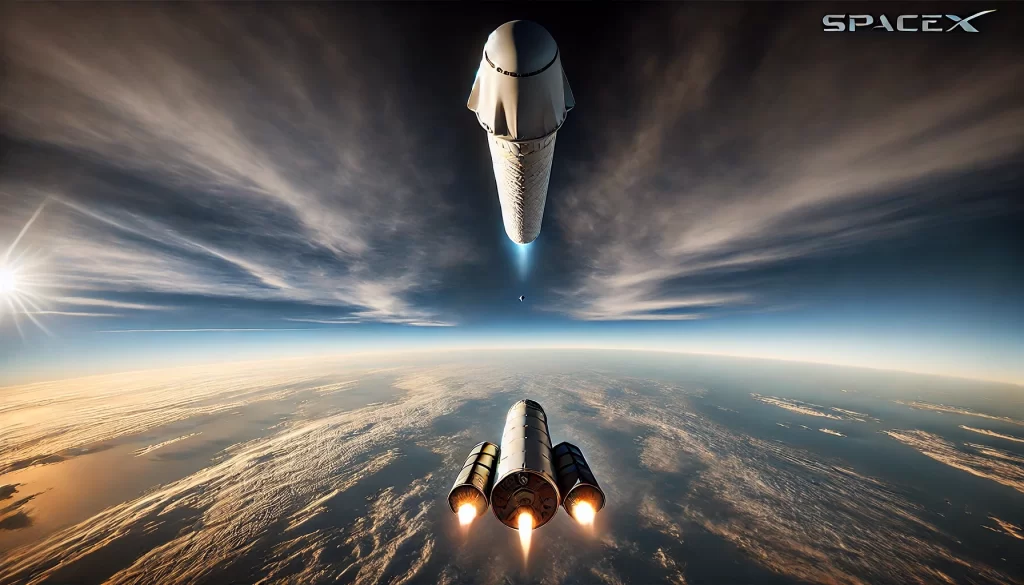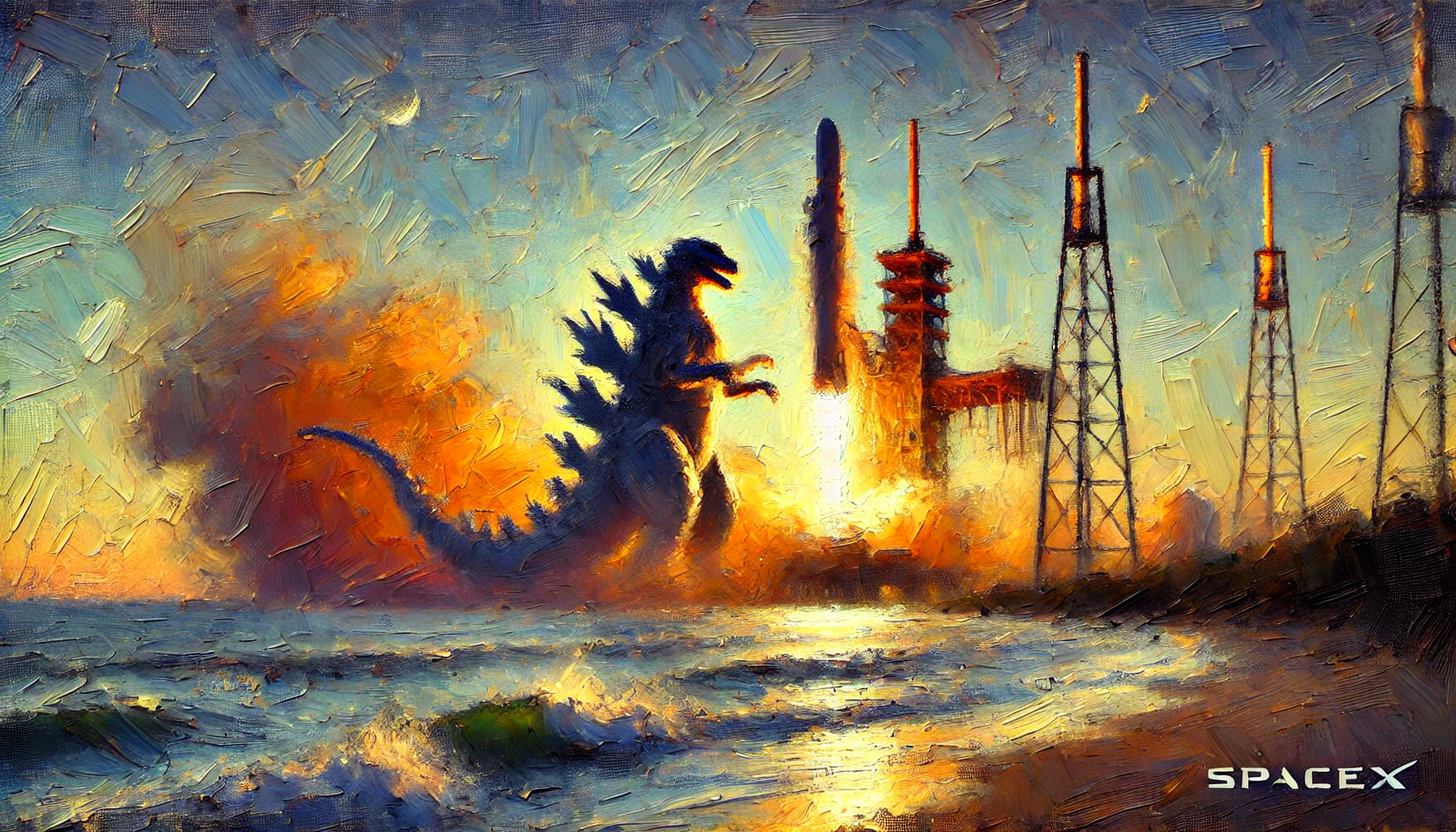On October 13, 2024, SpaceX completed its fifth test flight of the Starship and Super Heavy Rocket, marking a significant achievement in its space exploration efforts. The launch took place at the SpaceX Starbase in Boca Chica, Texas, and it was the first time that SpaceX successfully “caught” the booster of its Starship rocket using a specialized mechanical arm system known as “Mechazilla.”
The Starship system, standing nearly 400 feet tall, consists of two main components: the Super Heavy booster and the Starship spacecraft. This system is designed to be fully reusable, which could potentially allow for frequent and cost-effective missions to destinations like the moon and Mars. According to SpaceX, the booster was caught by the Mechazilla system shortly after it separated from the spacecraft, which continued its journey into space before safely landing in the Indian Ocean.
The booster catch was a complex maneuver. As the booster returned to Earth, it was guided by the Mechazilla’s large, chopstick-like arms attached to a tall tower. These arms closed around the booster as it descended, securing it to the launch pad with a precision that SpaceX engineers had meticulously planned for. SpaceX Founder Elon Musk celebrated the event by posting on social media, “The tower has caught the rocket!!”
Sunday’s successful test flight is an important step toward SpaceX’s vision of reusable rockets. This vision is inspired by Musk’s goal to make space travel as routine as commercial air travel. Traditionally, rockets are discarded after a single use, but SpaceX has been developing technology to bring rocket boosters back to Earth safely for reuse. The company has already achieved this with its Falcon 9 rocket, which lands on barges at sea or landing pads on land. However, the Starship booster aims for a more advanced system where it returns directly to the launch site, ready to be refueled and launched again.
In addition to its work with NASA on the Artemis program, which aims to send astronauts back to the moon, SpaceX is also planning Mars missions. Musk has stated that he hopes to conduct around five uncrewed Starship flights to Mars within the next two years, followed by potential crewed missions. For the moon missions, NASA is investing $4 billion in the Starship program. NASA plans to explore the moon’s South Pole, a region believed to have water ice, which could support life and even be used for rocket fuel in future Mars missions.

The Artemis program, which represents NASA’s return to lunar exploration, includes ambitious goals such as establishing a permanent lunar base. SpaceX’s Starship will play a crucial role in landing astronauts on the moon, with planned refueling operations in Earth’s orbit. This will involve a complex series of launches to send additional fuel tanks into orbit, where they will meet with the Starship before its journey to the moon. The hope is that these techniques will eventually support more extensive missions to Mars and beyond.
The successful catch of the booster has been a long-awaited moment for SpaceX, whose previous Starship test flights saw mixed results, including several explosions. The company has been working on improving the rocket’s design, including upgrades to its heat shield and other structural changes to ensure safe landings. Despite the difficulties, SpaceX has made steady progress. NASA Administrator Bill Nelson commended the company, noting that these advancements will be vital for future space missions. He said, “As we prepare to go back to the moon under Artemis, continued testing will prepare us for the bold missions that lie ahead.”
In the broader space race, NASA is not alone in its lunar ambitions. Other countries, including China, India, and Japan, are also planning their own missions to the moon. For SpaceX, precision in landing and reusability are essential, as the company seeks to develop rockets that can quickly return to service. This accomplishment has been met with excitement from experts in the space community. Former astronaut Chris Hadfield expressed his enthusiasm on social media, saying, “Makes me even more excited for our collective future.”
The successful catch of the Starship booster is a promising step for SpaceX as it continues to develop technology that could make human life on other planets a reality. With each test, the company moves closer to its ambitious goals, including the possibility of colonizing Mars and expanding human presence in the solar system.
This article is based on the following articles:
https://www.usatoday.com/story/news/nation/2024/10/13/spacex-starship-launch/75583233007
https://www.npr.org/2024/10/13/nx-s1-5151788/spacex-starship-booster-caught-first-launch
https://www.washingtonpost.com/business/2024/10/13/spacex-starship-rocket-booster-launch

Background Information
SpaceX and Reusable Rockets
SpaceX is a private space exploration company founded by Elon Musk in 2002. Musk started the company with the goal of reducing space transportation costs and making it possible for humans to live on other planets, like Mars. SpaceX has introduced innovative technologies, including reusable rockets, which can return to Earth after launch and be used again. This is different from traditional rockets that are often discarded after a single use, which makes space missions more expensive.
The Falcon 9, one of SpaceX’s earlier rockets, was the first to feature reusable technology. This rocket can return to Earth and land vertically on a drone ship or a landing pad. SpaceX reuses parts of Falcon 9 for multiple launches, saving money and resources. The company’s latest rocket, Starship, is also designed to be fully reusable, but it is much larger and more powerful than Falcon 9.
Understanding Rocket Launches
Rockets are powerful vehicles that can carry satellites, supplies, and even people into space. A rocket launch involves burning large amounts of fuel to generate enough thrust, or force, to overcome Earth’s gravity. Most rockets have multiple stages. Once a stage has used up its fuel, it separates from the rest of the rocket and falls back to Earth.
For reusable rockets like Starship, this means that after the booster (the first stage) has done its job of lifting the rocket into space, it can return to the launch site for another use. This is an advanced technique because it requires the booster to control its descent, land safely, and not be damaged during the process.
NASA’s Artemis Program
The Artemis program is NASA’s project aimed at sending astronauts back to the moon for the first time since the Apollo missions in the 1960s and 1970s. Named after the Greek goddess of the moon, Artemis is focused on exploring the lunar South Pole, where scientists believe there is water ice that could be useful for future space missions. NASA’s goals include building a sustainable base on the moon and using it as a stepping stone for future missions to Mars.
As part of the Artemis program, NASA awarded SpaceX a contract to develop a version of Starship that can land astronauts on the moon. This lunar version of Starship will be used to transport astronauts from lunar orbit down to the surface of the moon and back again. The Artemis missions also involve other new technologies, such as lunar landers and orbiting space stations, which will support human exploration of the moon over the next several years.
Mars Colonization and Space Travel
Elon Musk and SpaceX have long-term goals of sending humans to Mars. Colonizing Mars means building a permanent human settlement there. This idea is based on the belief that humanity should become a “multi-planetary species,” meaning that people should live on more than one planet. SpaceX’s Starship rocket is being developed with this vision in mind, as it would have the power to carry astronauts and cargo to Mars.
Traveling to Mars is a significant challenge due to the distance and harsh environment. Mars is about 140 million miles away from Earth, and a trip there could take about six to nine months. To live on Mars, humans would need to find ways to get water, air, and food, and to protect themselves from extreme temperatures and radiation.
Environmental Concerns with Space Launches
Rocket launches, especially large ones like Starship, can have an impact on the environment. The powerful engines that lift rockets into space release gases and particles into the atmosphere. There is also concern about the effect of launches on the wildlife and ecosystems near launch sites. For instance, the SpaceX Starbase in Texas is close to wetlands and areas with unique plant and animal life. SpaceX has worked with government agencies to manage these concerns, but the impact of frequent launches is something scientists continue to study.

Debate/Essay Questions
- Is the concept of humans becoming a “multi-planetary species” essential for our survival, or is it an unrealistic and costly ambition?
- Should private companies like SpaceX lead space exploration, or should it remain the responsibility of government agencies like NASA?
Please subscribe to Insight Fortnight, our biweekly newsletter!
